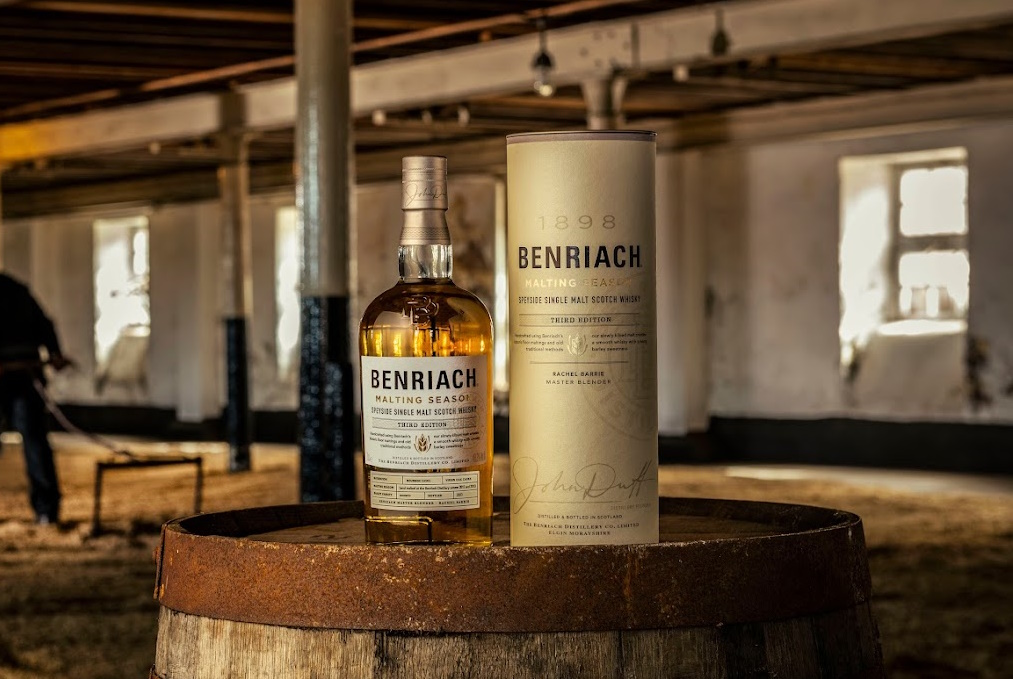Third edition of Malting Season with Benriach

The third edition of Benriach Malting Season will be in stores any day now. It is specially prepared for the traditional floor malt house at the distillery, which was reactivated a decade ago.
Benriach Malting Season Third Edition, 48.3% vol., was created from barley of the Concerto variety, malted in Benriach, and matured in a combination of fresh oak (virgin oak) barrels and first-fill bourbon barrels. Dr. Rachel Barrie, Benriach's master buyer, individually selects the barley variety, barrel type and strength for each annual Malting Season edition. According to the manufacturer, the third edition offers notes of freshly harvested barley, fruit from the orchard, wild bergamot, pears, honey and dried malt in the aroma. On the taste, expect creamy malt, clementines, vegetable honey, barley spiciness, apricots, almonds and wild cherries.
Benriach Malting Season Third Edition will soon be available through specialty aging liquor stores. The retail price of a single bottle has been set at £110.
The Benriach distillery is one of the few Scotch whisky factories to produce barley malt independently on a seasonal basis. Returning to the age-old tradition of malting barley, Benriach has joined the elite group of eight Scottish distilleries where this process continues despite the not-so-obvious economic benefits, or lack thereof. In addition to Benriach, independently malted Laphroaig, Bowmore and Kilchoman on Islay, Balvenie in Speyside, Glen Garioch in the Highlands, Highland Park in Orkney and Springbank in Campbeltown. In the vast majority of cases, in-house malt production is sufficient to meet no more than 20-30 percent of a distillery's needs. The only exception to this is Springbank, where an in-house malting plant fully meets the distillery's needs.
Traditionally, all Scottish distilleries prepared their own barley malt for their own production. It was like this until about the 1960s. and early 1970s. last century. Growing production at the time meant that traditional malting, based on floor malting, had become insufficiently efficient to meet the growing needs of the distilling industry. At the same time, modern industrial malting plants based on drum technology were developing. This one does not require huge areas and significant labor, and is largely carried out in an automated and now computerized manner. At that time, almost all distilleries gave up running malt houses and started sourcing their malt from just these large malt factories.
Floor malting involves submerging a batch of barley in water for a day or two, then spreading it on a concrete floor. Under the influence of moisture and temperature, natural enzymes are activated, under their influence the grains begin to germinate, and the starch contained in them gradually turns into water-soluble sugars. The process takes about a week, during which the sprouted barley is regularly repotted to prevent the sprouts from tangling and brewing the grain. The germination process is then interrupted when the grain goes to the malt dryer, where it is dried under the influence of hot air or peat smoke. This is traditionally done in buildings known to tourists as those sections of the distillery topped with a distinctive pagoda-shaped roof. These fans, for that is essentially what these pagodas are, were designed in the late 19th century by Scottish engineer Charles Doig to optimize the circulation of warm air or smoke and maximize the use of temperature to dry the wet malt, before that air or smoke leaves the drying chamber through openings in the top of this so-called pagoda. This design was first used at the Dailuaine distillery in Speyside and was quite quickly adopted throughout the distilling industry in Scotland. So much so that even the new distilleries, where no malt production is envisaged, very often refer to those solutions with their architecture, and the characteristic pagoda has become a symbol of Scottish whisky distilleries. The best-known examples of such new distilleries using a pagoda motif in their architecture are Ardnahoe on Islay, Ardnamurchan in the Highlands or Lochranza on the Isle of Arran. In most cases of old distilleries, the buildings of now-defunct malt dryers topped with pagodas or pagodas have taken on new uses, often related to serving tourists. This is the case, for example, in Ardbeg, where the local Visitor Center is located under two pagodas of one of the two disused malt dryers.
At Benriach, built in 1897, the malt house and malt drying room - topped by a classical pagoda - stood unused for several decades. It wasn't until 2013 that the then-owner, a consortium headed by Billy Walker, saw fit to bring the traditional malt house back to life. Smoke flowed again from under the pagoda crowning the roof of the drying room.
The current offerings of the House of Whisky Online include a wide selection of whiskies from the Benriach distillery, including earlier editions of Malting Season (information current at the time of preparing the current material). We invite you to visit and learn more about our offer.
[16.08.2023 / Photo: Benriach]